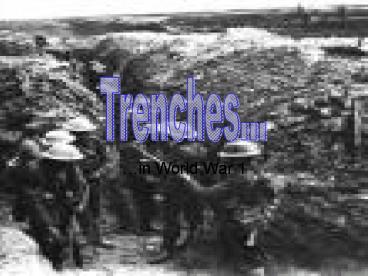in World War 1 - PowerPoint PPT Presentation
1 / 13
Title:
in World War 1
Description:
The trenches were infested with rats. There were sandbags to soak up the water ... the higher ground; however louse infestation and Trench fever affected the ... – PowerPoint PPT presentation
Number of Views:183
Avg rating:3.0/5.0
Title: in World War 1
1
Trenches...
- in World War 1
2
What did the trenches look like?
- Trenches in World War 1 were very small, dark,
narrow and wet and muddy. The trenches were
infested with rats. There were sandbags to soak
up the water and there were wooden fences at the
sides to stop the mud falling. On the right are
some pictures of the trenches before and now
Before
Now
3
A Day in the Life of a Soldier
- Morning stand to at dawn
- Given some rum
- Clean rifle equipment then be inspected
- Eat breakfast
- Battle and clean out trenches
- Stand to arms 1 hour before dusk
4
What food did the soldiers eat?
The daily rations for a British soldier are as
follows 20 ounces of bread 1/10 gill lime if
vegetables not issued 16 ounces of flour instead
of above ½ gill of rum 3 ounces of cheese
maximum of 20 ounces of tobacco 5/8
ounces of tea 1/3 chocolate optional 4
ounces of jam 4 ounces of oatmeal instead of
bread ½ ounce of salt 1 pint of porter
instead of rum 1/36 ounce of pepper 4
ounces of dried fruit instead of jam 1/20 ounce
of mustard 4 ounces of butter/margarine 8 ounces
of fresh vegetables or 2 ounces of dried
vegetables The daily rations for a German soldier
are as follows 26 ½ ounces of bread or 17 ½ of
field biscuits or 14 ounces of egg biscuit 53
ounces of potatoes 4 ½ ounces vegetables 2
ounces dried vegetables
5
Gas Warfare
"The vapour settled to the ground like a swamp
mist and drifted toward the French trenches on a
brisk wind. Its effect on the French was a
violent nausea and faintness, followed by an
utter collapse. It is believed that the Germans,
who charged in behind the vapour, met no
resistance at all, the French at their front
being virtually paralyzed." The destruction of
gas warfare had never been seen on a battlefield
until 1915. The first reported use of gas was by
the Germans on the Eastern Front on 3 January
1915.
6
Medical Care
The most gruesome task undertaken on the front
was recovering the injured and the dead from the
battlefield and no-mans-land. Some were horribly
wounded or mutilated, others had been killed on
the barbed wire fences or had lain dead for days.
Stretcher parties of volunteers, soldiers and
prisoners of war undertook this appalling job,
often under enemy fire.
7
Ypres
8
Ypres
For centuries Ieper (Ypres in French and known to
the British throughout the First World War as
Wipers), was one of the great cloth marketing
towns along with Ghent and Bruges. It was their
decision to fight with the French in 1383 (over
the succession of the Pope) that was too lead to
their downfall. You can walk around the ramparts
to or from the Menin Gate, and alongside the
Rijelse Poort you will find the only British
Cemetery within the town. This is the small
Ramparts Cemetery. The familiar headstones
looking out across the moat, where on a summers
day children will be found boating.
9
Boredom and Fear
Daily life in a trench alternated between long
amounts of sheer boredom, made worse by the
discomfort of living partially underground,
punctuated by short amounts of intense fear when
the enemy attacked or bombarded the trench. These
events were rare, though. Far more common were
the alternating exchange of gunfire between the
opposing trenches. To cope with the stress of
trench life, most soldiers spent 7-10 days at the
front before moving back to the reserve lines and
then back again, well away from the front itself,
to a rest area. Here they could have a bath,
clean and delouse their clothes and prepare to
return to active duty at the front once again.
10
The Trenches Activity
- Read the following extract from German
Deserters War Experience then list words to
describe what it was like to be in a trench in
World War One. - It was dark, and it rained and rained. From all
directions one heard in the darkness the wounded
calling, crying, and moaning. The wounded we had
with us were likewise moaning and crying. All
wanted to have their wounds dressed, but we had
no more bandages. We tore off pieces of our dirty
shirts and placed the rags on those sickening
wounds. Men were dying one after the other. There
were no doctors, no bandages we had nothing
whatever. You had to help the wounded and keep
the French off at the same time. It was an
unbearable, impossible state of things. It rained
harder and harder. We were wet to our skins. We
fired blindly into the darkness. The rolling fire
of rifles increased, then died away, then
increased again. We sappers were placed among the
infantry. My neighbour gave me a dig in the
ribs."
11
Diagram of the Trenches
Key Communication Trench Machine Gun
Nest Underground Bunker Traverse Wire
Break Listening Post Trench Block
12
A Close-Up Look at a Trench
13
Life in a German Trench
- The German trenches were quite different as they
were designed as semi-permanent features which
were part of a policy of defence in depth. The
Germans constructed deep, shellproof dugouts,
sometimes with two levels, which were usually
better drained as they were on the higher ground
however louse infestation and Trench fever
affected the Germans just as badly as it affected
the British.






























